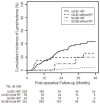Risk of lymphedema after mastectomy: potential benefit of applying ACOSOG Z0011 protocol to mastectomy patients
- PMID: 24500108
- PMCID: PMC4011490
- DOI: 10.1007/s10549-014-2856-3
Risk of lymphedema after mastectomy: potential benefit of applying ACOSOG Z0011 protocol to mastectomy patients
Abstract
Axillary lymph node dissection (ALND) and radiation therapy (RT) are commonly recommended for mastectomy patients with positive sentinel lymph node biopsy (SLNB). Effective alternatives to ALND that reduce lymphedema risk are needed. We evaluated rates of lymphedema in mastectomy patients who received SLNB with RT, compared to ALND with or without RT. 627 breast cancer patients who underwent 664 mastectomies between 2005 and 2013 were prospectively screened for lymphedema, median 22.8 months follow-up (range 3.0-86.9). Each mastectomy was categorized as SLNB-no RT, SLNB + RT, ALND-no RT, or ALND + RT. RT included chest wall ± nodal radiation. Perometer arm volume measurements were obtained pre- and post-operatively. Lymphedema was defined as ≥10 % arm volume increase. Kaplan-Meier and Cox regression analyses were performed to determine lymphedema rates and risk factors. Of 664 mastectomies, 52 % (343/664) were SLNB-no RT, 5 % (34/664) SLNB + RT, 9 % (58/664) ALND-no RT, and 34 % (229/664) ALND + RT. The 2 year cumulative lymphedema incidence was 10.0 % (95 % CI 2.6-34.4 %) for SLNB + RT compared with 19.3 % (95 % CI 10.8-33.1 %) for ALND-no RT, and 30.1 % (95 % CI 23.7-37.8 %) for ALND + RT. The lowest cumulative incidence was 2.19 % (95 % CI 0.88-5.40 %) for SLNB-no RT. By multivariate analysis, factors significantly associated with increased lymphedema risk included RT (p = 0.0017), ALND (p = 0.0001), greater number of lymph nodes removed (p = 0.0006), no reconstruction (p = 0.0418), higher BMI (p < 0.0001) and older age (p = 0.0021). In conclusion, avoiding completion ALND and instead receiving SLNB with RT may decrease lymphedema risk in patients requiring mastectomy. Future trials should investigate the safety of applying the ACOSOG Z0011 protocol to mastectomy patients.
Conflict of interest statement
The authors have no conflicts of interest to disclose.
Figures
References
-
- Ahmed RL, Prizment A, Lazovich D, Schmitz KH, Folsom AR. Lymphedema and quality of life in breast cancer survivors: the Iowa Women’s Health Study. Journal of clinical oncology : official journal of the American Society of Clinical Oncology. 2008;26 (35):5689–5696. doi: 10.1200/JCO.2008.16.4731. - DOI - PMC - PubMed
-
- Hayes SC, Janda M, Cornish B, Battistutta D, Newman B. Lymphedema after breast cancer: incidence, risk factors, and effect on upper body function. Journal of clinical oncology : official journal of the American Society of Clinical Oncology. 2008;26 (21):3536–3542. doi: 10.1200/JCO.2007.14.4899. - DOI - PubMed
Publication types
MeSH terms
Grants and funding
LinkOut - more resources
Full Text Sources
Other Literature Sources
Medical


